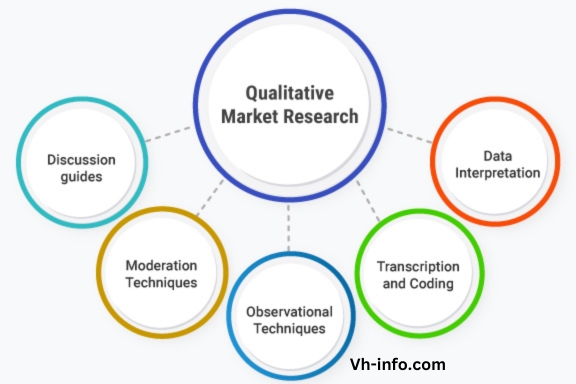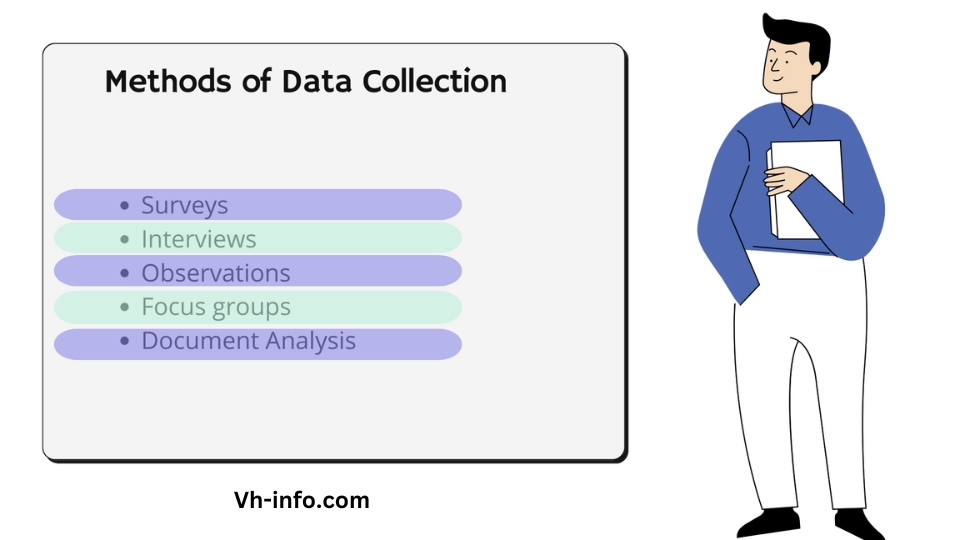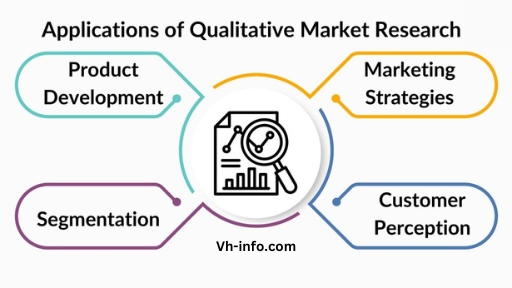As a marketer, you know that the key to success is understanding your target audience. But how do you do that?
One of the most valuable tools at your disposal is qualitative research. Qualitative marketing research is all about understanding the motivations, attitudes, and behaviors of your target audience by asking open-ended questions and observing their actions.
It helps you get inside the minds of your customers and gain valuable insights that can inform everything from product development to marketing strategies.
In this blog, we will cover everything you need to know about qualitative marketing research – what it is, why it’s important, different types of research methods, data collection techniques, advantages and disadvantages, data analysis tips, real-life examples of successful qualitative research projects, and more.
So let’s dive in!
What Is Qualitative Marketing Research?

Qualitative marketing research is a method that delves into the motives behind consumer behavior by using observation techniques and open-ended questioning, such as individual interviews and group discussions. It focuses on collecting and analyzing non-numerical data to uncover the underlying reasons driving purchasing decisions and explore customers’ values and beliefs.
This approach, often employing “what,” “how,” and “why” questions, aims to gather feedback on new products or services before launch, revealing perceptions, needs, and potential advantages or drawbacks. With a focus on understanding consumers’ beliefs and experiences, qualitative marketing research helps researchers grasp the factors influencing behavior within a specific market, emphasizing in-depth analysis with relatively small sample sizes.
Importance of Qualitative Research in Marketing

Here are some of the key reasons why qualitative research is important for marketing:
- Reveals motivations – Qualitative research uncovers deeper insights into consumer motivations, needs and wants that quantitative data cannot provide. This helps marketers understand why consumers make certain decisions.
- Identifies new opportunities – Focus groups, interviews etc. can reveal unmet consumer needs and new product opportunities that surveys may miss. Enables innovation.
- Provides context – Observations and immersing in the customer experience through ethnography provides invaluable context about consumer behaviors.
- Captures emotions & feelings – Projective techniques and one-on-one interviews allow consumers to express emotions and feelings about a product or service that they may not directly state on a survey.
- Fleshes out quantitative data – Qualitative research puts meat on the bones of quantitative data like ratings and usage statistics. Provides the complete picture.
- Tests concepts – Presenting advertising, products etc. to focus groups early on allows marketers to test concepts and make improvements before investing heavily.
- Identifies positioning – Qualitative techniques can identify effective messaging and positioning that resonates emotionally with different target demographics.
- Gauges reactions – Direct consumer reactions to pricing, advertising, packaging etc. through interviews and focus groups can help gauge initial reactions and make refinements.
Techniques & Ways to do Qualitative Market Research
Here are the steps to do qualitative market research:
- Planning & Determining research objectives: For every research study, it’s important to know what we want to find out from the beginning. This way, we don’t waste time and resources, and it helps us be more flexible in business decisions.
- Deciding the method to conduct the research: There are many ways to do qualitative market research. We choose how to do it based on things like the type of study, who we’re studying, where they are, and what product we’re looking at.
- Getting the right personnel for the job: To do a qualitative market research study, we need moderators who know how to ask questions and keep track of the answers from the people being studied.
- Sampling: The group of people we choose for a qualitative market research survey is really important. The better the group, the better the results, making the study more successful. There are three main types of sampling:
- Purposive Sampling: This means we pick people on purpose, with specific characteristics in mind. We plan who we want to include based on demographics before starting the survey.
- Quota Sampling: We select samples from a set quota, and these chosen people represent the larger population. It can be random or have certain criteria.
- Snowball Sampling: This works like a chain. People who fit the criteria are asked to refer others they know who also meet the criteria.
- Survey design: When making a survey, it needs to be designed in a way that gets the most useful information. This helps us gather strong and practical feedback from the responses we receive.
- Data collection: We can gather information either online or offline. It’s important to collect the data in a way that makes sense, so we can analyze it and report on it later.
- Data Analysis: Information doesn’t mean much unless we look at it closely. When we analyze data, we get useful insights that can help improve a product or brand. This is really important for qualitative marketing research.
- Reporting: After collecting and looking at the information, we need to present it in a way that’s easy for everyone to understand. This is a big step in the market research process and is shared with the people who are interested.
Advantages and Disadvantages of Qualitative Marketing Research

Qualitative market research can really help marketers and companies in a lot of ways.
Some of the benefits include:
- In-depth data: Qualitative market research goes deeper than just looking at basic numbers. Instead of just saying if a brand is doing good or not, it helps find ways to improve by understanding why it’s in a certain place in the market. For instance, it looks into how people feel about different brands and why. This helps a company give customers experiences they enjoy and avoid things they don’t like.
- Flexibility: Qualitative research allows researchers to adjust their methods for better findings. If group opinions are swayed by the group setting, researchers can talk to individuals separately. Alternatively, they can hold an online group discussion to give everyone a chance to share their thoughts and control the conversation easily.
- Ideation: Some ways of doing qualitative market research can give brands ideas for making new products and doing marketing. For example, focus groups might come up with cool new things to add to a product. Journals and interviews can show how most customers talk and feel, and this can be used in marketing messages.
- Customer Retention: Doing qualitative research can tell a brand what customers really want from a product and the company. It helps see if the brand is doing what customers need and like. This information is useful for making the product better, improving marketing, and giving good customer support to keep existing customers happy.
- Helps communicate brand proposition accurately: This way of doing market research lets customers and the brand talk to each other easily. They can share their needs and values without any confusion, making sure everyone understands each other well.
Some of the Challenges include:
- Time-Consuming: Qualitative market research can take a long time, from days to even years. This isn’t good if you want quick insights to act on. Sometimes, by the time the research is done, things in the market have already changed, and what we thought at the start might not be true anymore.
- Expensive: Because it takes a long time to finish, doing qualitative market research costs a lot of money. It’s also expensive because it needs skilled people to handle the big amount of data and make useful insights for action.
- Small Sample Sizes: Qualitative market research uses a small group to represent a larger audience. However, this may result in less accurate data. To include more diverse opinions, multiple small groups can be used, such as two or three separate focus groups.
- Bias: Qualitative market research can be biased, leading to unfair results. Similar opinions from a study group may not represent the majority, and some voices might hold more weight than others. Researchers could also accidentally influence participants by their questions, which would disrupt the outcome. Hence, moderators must be impartial and careful during research to avoid issues.
- Feasibility: Qualitative market research is flexible and adaptable. For larger or expensive products, sending them to participants’ homes may not be feasible. Maintaining confidentiality can be a concern when sharing secret products with friends. To address these challenges, researchers should find local participants, provide clear product usage instructions, and emphasize the importance of keeping secrets confidential.
- Halo effect: Because qualitative research depends a lot on personal opinions, the person leading the research or analyzing it might influence the results. People usually lean towards what they already know, and it’s hard to avoid this bias in research.
Qualitative Data Collection Methods

Developing Qualitative Surveys or Questionnaires
For graduate students working on their dissertations, whether it’s qualitative or quantitative market research, defining your target audience is crucial before developing questions.
Consider if there are any specific criteria for inclusion or exclusion, like age, country of origin, or native language. Early survey questions should focus on exclusions to ensure accurate results. Qualitative surveys typically use open-ended questions, avoiding multiple-choice ones.
However, for exclusionary data, you may use multiple-choice questions in a digital survey to screen participants. It’s important to craft unbiased questions, steering clear of unconscious biases.
Once your survey is ready, distribute it digitally or through mail to collect the qualitative data needed for your research.
Conducting Interviews to Collect Qualitative Data
Another way to collect qualitative data is through one-on-one interviews. These are more personal than surveys, making them a favorite for many researchers.
However, interviews take more time than surveys, so they’re not the quickest method.
In a qualitative interview, you can be more flexible and informal compared to a structured quantitative interview. Researchers can go off the script, ask more questions based on the conversation, and explore interesting topics that come up during the interview.
Holding a Focus Group for Your Dissertation Research
Focus groups are a common way to collect information in qualitative research. Keep in mind that what participants say in a focus group might be affected by what others say or just by being there.
Running a focus group is straightforward. Keep the number of participants in each group between six to ten. Set some rules, like no interrupting or making judgmental comments.
You, as the moderator, will guide the discussion. Prepare some questions beforehand, but be ready to ask new ones during the session. Don’t forget to record the focus group discussions so you can analyze them later.
Collecting Qualitative Data via Observations
Watching people in their natural setting is a helpful way to gather qualitative data, especially when you need to observe them in their usual environment. Observational studies can be open, where participants know you’re observing them, or secret, where you blend in and quietly watch without being noticed.
For example, you might pretend to be another ESL student or someone learning to be an ESL teacher to quietly observe what’s happening.
In-home videos
In-home videos let researchers see how customers use a product in their own homes, where they feel comfortable. This way, we can watch how people naturally interact with the product. Users can make video diaries or record videos with detailed comments about the product. Putting all this info in one place helps us analyze and use it again later in the future.
Lifestyle immersion
Lifestyle immersion is a way to get customer feedback in a relaxed setting. It means the researcher gets deeply involved in a customer’s life.
For example, the researcher might go to a party or family event and see how the person reacts and behaves in a familiar place. Watching how users talk to their family and friends is a helpful way to understand more about what they need and what motivates them.
Ethnographic Research

Ethnography is a way of studying people that started in anthropology. Instead of using a lab, researchers watch how people do everyday things like grocery shopping or cooking in their natural environment. This helps us understand what people really do, not just what they say they do.
In ethnography, researchers use different methods like watching directly, recording videos, keeping diaries, and taking pictures. They can watch people at home, work, or with their friends. Passive observation means just watching without talking to them, while active observation involves talking to people, asking questions, and maybe even joining their group.
Reviewing Records or Archives for Your Dissertation Research
Looking at records or archives is a type of research where you check information already gathered by someone else. This includes documents, pictures, videos, or audio recordings. Some collections are now online.
Quantitative marketing research is used by analysts to get solid statistical data, but it has downsides. It doesn’t explain why the numbers are the way they are. Data analysts help by figuring out patterns and useful insights. Sometimes, the reliability of quantitative research depends on how many people were in the study and how the info was collected.
Applications of Qualitative Market Research

Companies usually use qualitative market research for:
Product Development
Knowing what customers like in products and why it’s important can help make new things. For instance, if research says people really like computer keyboards that give a good feeling when you press the keys, a company that makes computer stuff could work on making more keyboards like that.
Marketing Strategies
Watching people shop and observing them helps researchers see how they naturally react to things like packages and displays. Talking to people in groups or one-on-one can also show how they feel about the way an ad looks or sounds. Studying what people do and say can help marketers make strategies that appeal to lots of different people.
Customer Perception
What people think about a brand can help the brand decide how to keep, improve, or change its image.
For example, if people in groups say they really like a coffee shop’s friendly vibe, the company might try to get rid of things that make it less welcoming, like a strict buying rule. They might also make the place cozier by adding sofas or putting out magazines.
Segmentation
Segmentation means figuring out different groups in a bigger group of people who share similar things, like where they live, how much money they have, or how old they are. Talking to people one-on-one or in groups can help figure out who uses a product, how they use it, and why. This information helps customize marketing for each group of people.
Tips for Qualitative Data Analysis (to Help You Understand Your Customers)
Here are some tips for analyzing qualitative data to gain customer insights:
- Summarize the key points. Read through all the qualitative data and highlight the main takeaways, key quotes, and recurring themes. Summarize the key points from each interview, focus group etc. This condenses the data into the most impactful findings.
- Code the responses. Go through the data again and assign codes or labels to important quotes, comments, and observations that relate to key themes. For example, positive feedback about a product feature would get a “positive product feedback” code. Coding helps organize the data into categories.
- Create a word cloud. A visual word cloud can quickly showcase the most frequently used words and themes from open-ended surveys, interviews etc. The dominant words give insight into top of mind topics, concerns, and emotions. Word clouds turn qualitative data into an interactive visual.
- Look for patterns. Review the summaries, codes, and word cloud to identify patterns across the data. For example, you may see common complaints, suggested improvements, or shared values emerge across multiple responses. Recurring patterns reveal core insights.
- Craft consumer personas. Use the qualitative data to build detailed, personalized consumer personas that reflect the key motivation, attitudes, and behaviors uncovered around your product or service.
- Extract powerful quotes. Identify compelling quotes that vividly capture consumer experiences, perceptions, and feelings towards your brand. These quotes put a human face and voice to the qualitative insights.
- Present key findings visually. Charts, graphs, and visual diagrams can help communicate key qualitative findings and consumer insights to stakeholders. Pictures and visuals make the insights more memorable.
What Is the Best Type of Marketing Research? Choosing Between Quantitative vs. Qualitative Market Research
The best type of marketing research depends on what you want to find out. If you’re trying to describe how users feel about something, qualitative research is good. But if you need specific data about a group of people or want to compare different groups, then quantitative research is better.
Qualitative research is like having a conversation with your customers. It’s great for understanding how people see your brand compared to others, learning about who buys your products, checking how well your marketing is doing, and figuring out what features people like in your products.
Quantitative research is more structured and focused. It’s like testing a theory. You can study larger groups, do the research again to double-check, and apply the findings to a bigger audience. Stakeholders usually like this approach because it’s precise and widely accepted.
So, it really depends on your research question – if you want a chat with customers, go qualitative; if you want hard numbers and clear results, go quantitative.
Qualitative Market Research Examples
Qualitative market research helps brands become more trustworthy, understand their customers better, find out what’s popular in the market, make more people aware of their products, change how their products look, and hear what customers like.
Let’s see how McDonald’s, Starbucks, and LEGO use information to face strong competition.
McDonald’s

When McDonald’s does market research, they ask customers important questions about their best products, how much things should cost, which ads work well, and which restaurants people like the most. These answers help them see if more people are becoming their customers.
Also, McDonald’s listens to feedback from customers to make their products better. Some customers wanted healthier and organic choices, so McDonald’s added things like apple slices to the menu. They even ran ads to show that their chicken nuggets and burgers are made from real meat.
Starbucks

Starbucks values customer feedback. You can share your thoughts on their website, Twitter, or social media. They also let customers try new things in stores. From 2008 to 2018, they had a platform called My Starbucks Idea where people shared suggestions. Over 275 ideas were implemented, resulting in new products and increased responsibility.
LEGO

LEGO wanted to be inclusive, so they started making toys for all genders. They conducted market research by asking 3,500 girls and their parents how they play with toys. This helped them develop a new toy line called “Friends” specifically for girls. Market research is essential for companies to create new products, improve existing ones, and understand customer preferences. By understanding your customers’ needs and concerns, you can create a great product.
How to Design Qualitative Research?
How well your research goes depends a lot on good planning and the right strategy.
Let’s talk about some general tips on how to do qualitative research.
Determine Research Objectives
When you start planning qualitative market research, the first thing is to know what you want to find out. This means understanding the goals of your study.
These goals could be about figuring out where your product or brand stands, understanding what people think about your company or product, checking how people respond to ads, packaging, or design, testing how easy your website is to use, and finding strengths and weaknesses in your product.
Without clear goals, it’s tough for the researcher because qualitative research involves open-ended questions and detailed answers that can be tricky to understand right away.
Choose the Methodology to Conduct the Research
Decide the best way to do market research by considering things like who your audience is, where they live, how they live, and what product you’re looking at. Market researchers often work with experts to find and check the people taking part.
The researcher’s job is to make a list of things to talk about in small groups. Moderators, who ask questions, watch reactions, and analyze behavior, spend about 90 to 120 minutes with each group.
Investigate various Data Collection Methods
After picking how you want to observe, get a moderator to watch how people act and write down notes. This might need a video camera or a special mirror. You can also mix both qualitative and quantitative research to get both numbers and comments from customers.
For focus groups, you can have one discussion with 8-10 people or a series of online meetings over a few days. People will answer questions from the moderator or respond to recorded videos.
If you choose one-on-one interviews, you can talk to people on the phone or meet them in person. This is good if you want customers to try the product and tell you what they think.
Analyze the Collected Data
Researchers usually take a few days to a few weeks to get all the information.
After that, they look at the data to answer your questions. Then comes something called qualitative coding, which means sorting the findings into categories to find themes and patterns.
Sometimes, they also use numbers to explain what the data is showing. The report might also include a storytelling analysis of the main messages and phrases.
Study the Report and Recommendations
The last thing is to check the report made by the researchers. It could be a paper or a video. The paper, following MECE principles, helps you organize patterns and similarities based on things like age or where people live.
In it, there will be suggestions so you can figure out things and start making your product marketing better.
Before you go….
Qualitative research allows marketers to explore customer motivations and uncover insights that drive purchase decisions.
By utilizing techniques like focus groups and interviews, qualitative data can inform segmentation strategies and positioning for greater resonance with TOFU and BOFU audiences.
With an emphasis on the 5 Ps of marketing, qualitative insights enable refined messaging and paid acquisition targeting.
By uncovering unmet needs, qualitative research facilitates focused differentiation and drives innovation through new product development.
Effective analysis using coding and word clouds helps extract maximum value from qualitative data.
Conclusion
In conclusion, qualitative research is a powerful tool for marketers to gain valuable insights into customer behavior, preferences, and perceptions.
It allows you to dig deep and understand the “why” behind consumer actions, helping you make informed decisions and create effective marketing strategies.
By using qualitative research methods such as interviews, focus groups, and observations, you can uncover rich and meaningful data that quantitative research alone cannot provide.
Remember to carefully analyze and interpret the collected data, summarizing key points, coding responses, and creating word clouds to visualize patterns and trends.
With qualitative research, you can truly understand your customers and tailor your marketing efforts to meet their needs and expectations.
So, embrace the power of qualitative research and make it your best friend in the world of marketing.

